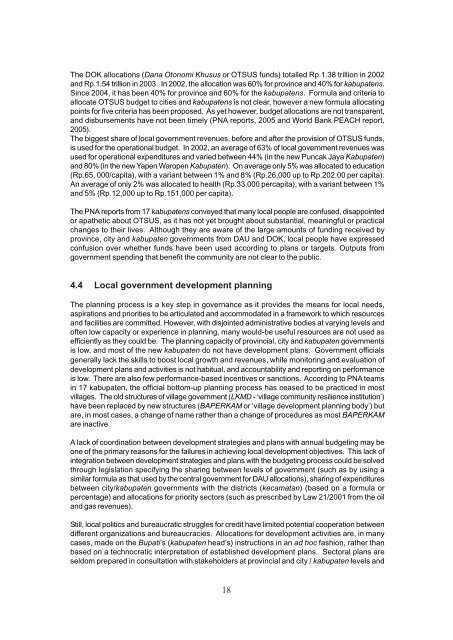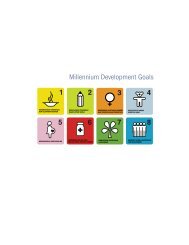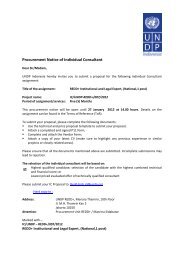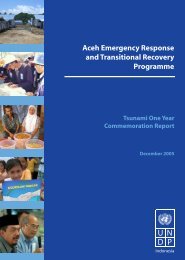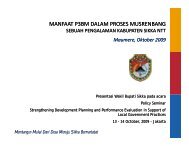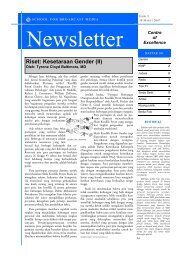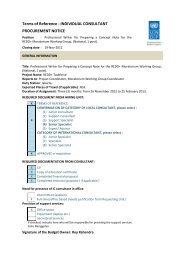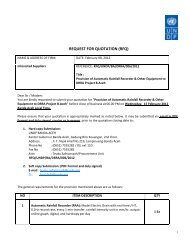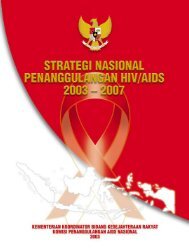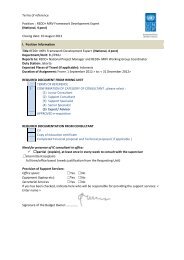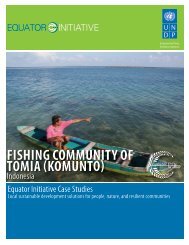Papua Needs Assessment - UNDP
Papua Needs Assessment - UNDP
Papua Needs Assessment - UNDP
You also want an ePaper? Increase the reach of your titles
YUMPU automatically turns print PDFs into web optimized ePapers that Google loves.
The DOK allocations (Dana Otonomi Khusus or OTSUS funds) totalled Rp.1.38 trillion in 2002<br />
and Rp.1.54 trillion in 2003. In 2002, the allocation was 60% for province and 40% for kabupatens.<br />
Since 2004, it has been 40% for province and 60% for the kabupatens. Formula and criteria to<br />
allocate OTSUS budget to cities and kabupatens is not clear, however a new formula allocating<br />
points for five criteria has been proposed. As yet however, budget allocations are not transparent,<br />
and disbursements have not been timely (PNA reports, 2005 and World Bank PEACH report,<br />
2005).<br />
The biggest share of local government revenues, before and after the provision of OTSUS funds,<br />
is used for the operational budget. In 2002, an average of 63% of local government revenues was<br />
used for operational expenditures and varied between 44% (in the new Puncak Jaya Kabupaten)<br />
and 80% (in the new Yapen Waropen Kabupaten). On average only 5% was allocated to education<br />
(Rp.65, 000/capita), with a variant between 1% and 8% (Rp.26,000 up to Rp.202.00 per capita).<br />
An average of only 2% was allocated to health (Rp.33,000 percapita), with a variant between 1%<br />
and 5% (Rp.12,000 up to Rp.151,000 per capita).<br />
The PNA reports from 17 kabupatens conveyed that many local people are confused, disappointed<br />
or apathetic about OTSUS, as it has not yet brought about substantial, meaningful or practical<br />
changes to their lives. Although they are aware of the large amounts of funding received by<br />
province, city and kabupaten governments from DAU and DOK, local people have expressed<br />
confusion over whether funds have been used according to plans or targets. Outputs from<br />
government spending that benefit the community are not clear to the public.<br />
4.4 Local government development planning<br />
The planning process is a key step in governance as it provides the means for local needs,<br />
aspirations and priorities to be articulated and accommodated in a framework to which resources<br />
and facilities are committed. However, with disjointed administrative bodies at varying levels and<br />
often low capacity or experience in planning, many would-be useful resources are not used as<br />
efficiently as they could be. The planning capacity of provincial, city and kabupaten governments<br />
is low, and most of the new kabupaten do not have development plans. Government officials<br />
generally lack the skills to boost local growth and revenues, while monitoring and evaluation of<br />
development plans and activities is not habitual, and accountability and reporting on performance<br />
is low. There are also few performance-based incentives or sanctions. According to PNA teams<br />
in 17 kabupaten, the official bottom-up planning process has ceased to be practiced in most<br />
villages. The old structures of village government (LKMD - ‘village community resilience institution’)<br />
have been replaced by new structures (BAPERKAM or ‘village development planning body’) but<br />
are, in most cases, a change of name rather than a change of procedures as most BAPERKAM<br />
are inactive.<br />
A lack of coordination between development strategies and plans with annual budgeting may be<br />
one of the primary reasons for the failures in achieving local development objectives. This lack of<br />
integration between development strategies and plans with the budgeting process could be solved<br />
through legislation specifying the sharing between levels of government (such as by using a<br />
similar formula as that used by the central government for DAU allocations), sharing of expenditures<br />
between city/kabupaten governments with the districts (kecamatan) (based on a formula or<br />
percentage) and allocations for priority sectors (such as prescribed by Law 21/2001 from the oil<br />
and gas revenues).<br />
Still, local politics and bureaucratic struggles for credit have limited potential cooperation between<br />
different organizations and bureaucracies. Allocations for development activities are, in many<br />
cases, made on the Bupati’s (kabupaten head’s) instructions in an ad hoc fashion, rather than<br />
based on a technocratic interpretation of established development plans. Sectoral plans are<br />
seldom prepared in consultation with stakeholders at provincial and city / kabupaten levels and<br />
18


